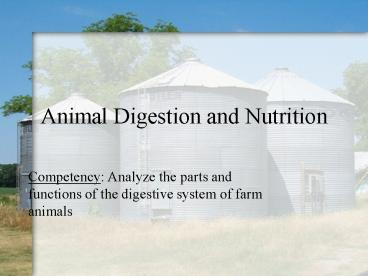Animal Digestion and Nutrition PowerPoint PPT Presentation
1 / 36
Title: Animal Digestion and Nutrition
1
Animal Digestion and Nutrition
- Competency Analyze the parts and functions of
the digestive system of farm animals
2
Ruminants
- Objective Describe the function and major parts
of the digestive system of ruminants.
3
Ruminant Animals
- Animals with complex digestive systems
- Capable of digesting material with a high fiber
concentration - Uses microbial fermentation
- Cattle
- Sheep
- Goats
- Deer
4
Ruminants
Ruminant Digestive System
5
Parts and Functions
- Mouth
- Bites and chews
- Esophagus
- Connection
- Four Compartment Stomach
- Rumen
- Reticulum
- Omasum
- Abomasum
6
Parts and Functions
- Rumen
- Largest of the four parts room-in-it
- Filled with bacteria
- Converts large amounts of roughage to amino acids
- Fact!!!!
- The average cow rumen can hold over 160 liters
(40 gallons)
7
Rumen
8
Rumen Microbe
9
Rumen Microbe
- The large microbe is a type of protist
- The creature that looks like a tadpole attached
to the side of the protist is a fungal spore - The smaller, rod-shaped beasts lining the
underside of the protist are bacteria.
10
Parts and Functions
- Reticulum
- Compartment where liquid goes
- Honeycomb in structure
- Omasum
- Grinds and squeezes
- Removes some liquid
- Abomasum
- True stomach
- Enzymes and acids
11
Parts and Functions
- Small Intestine
- Partially digested feed is mixed
- Bile
- Pancreatic juice
- Intestinal juice
- Most of the food nutrient is absorbed
- Villi or Papillae
12
Parts and Functions
- Large intestine
- Main function is to absorbed water
- Add mucus to undigested feed
- Feces
13
Non-Ruminant
- Objective Describe the function and major parts
of the digestive system of non-ruminants.
14
Non-Ruminant
- Simple digestive system
- (Monogastric)
- Feed must be highly quality concentrates
- Cannot digest large amounts of fiber
- Human
- Dogs
- Cats
- Rabbits
- Pigs
- Horses????
15
Non-Ruminant Parts Functions
- Mouth
- Esophagus
- Stomach
- Enzymes acts on feed
- Churns and mixes
- Small intestine
- Large intestine
16
Non-Ruminant Parts Functions
- Accessory system
- Liver
- Produces bile that acts on fat
- Pancreas
- Produces insulin
- Anus
- End of the digestive tract
17
Monogastric
Simple Digestive System
18
Poultry Digestive Systems
- Objective Describe the function and major parts
of the digestive system of non-ruminants.
19
Poultry
- Chickens
- Turkeys
- Ducks
- Geese
20
Poultry Digestive Systems
- Mouth or beak
- Can not chew food
- Esophagus
- Connects mouth to crop
- Crop
- Stores feed
21
Poultry Digestive Systems
- Gizzard
- Crushes feed
- Contains grit and gravel
- Mixes feed with digestive juices
- Liver
- Small and Large Intestine
- Vent
- Removes solid and liquid waste
22
Inspecting Animal Digestive Systems
- Esophagus
- Tube like structure
- Stomach
- Pouch with undigested feed
- Liver
- Large brown organ beneath the stomach or crop
23
Inspecting Animal Digestive Systems
- Small intestine
- Long tube
- Gray colored partially digested feed
- Large intestine
- Large relatively short compartment
- Contains fecal material
24
Nutrients
- Competency Distinguish the functions and sources
of feed nutrients for farm animals
25
Groups of Nutrients
- Objective Identify the six major groups of
nutrients
26
Carbohydrates
- Composed of sugar, starches, cellulose and lignin
- Provide energy and heat
- Make up the largest quantity of livestock feed
- Carbon
- Hydrogen
- Oxygen
27
Fats and Oils
- 2.25 times the energy value of carbohydrates
- At body temperature fat are solids and oils are
liquid - Example cooking lard
- Extra carbohydrates are stored as fats
- Carbon, hydrogen, oxygen
- Carriers fat-soluble vitamins
28
Proteins
- Major component of muscles and tissues
- Made up of amino acids
- Continuously needed to replace dying body cells
- Young animals need large amounts for growth
Organic
29
Vitamins
- Needed in small quantities
- Helps regulate body functions
- Designated by letters
- A,B,C,D,E,K
- Sources
- Naturally found in feed
- Feed additives made from animal by-products
- Made by the body itself
Organic
30
Minerals
- Needed in small amounts
- Calcium, phosphorus, sodium, etc.
- Regulates body functions
- Provide growth for
- Bone
- Teeth
- Tissue
- Example calcium is needed in poultry for
eggshell development
31
Water
- Makes up 40 to 60 of the animals body
- Dissolves other nutrients and helps carry them to
parts of the body
32
Sources of Nutrients
- Carbohydrates
- Cereal grains
- corn
- wheat
- oats
- rye
- barley
- sorghum
33
Sources of Nutrients
- Proteins
- Plant sources
- Soybean meal
- Cottonseed meal
- Alfalfa meal
- Animal sources
- Meat meal
- Fishmeal
- Dried milk
- Synthetic nitrogen source called urea
34
Sources of Nutrients
- Fats and Oils
- Grains and protein concentrates
- Vitamins and Minerals
- Most feed ingredients
- Supplements
- Pre-mixes
- Mineral blocks
35
Sources of Nutrients
- Other sources and exceptions
- Alfalfa (roughage) can be used to provide energy
and fiber - Molasses
- Improve taste (palatability)
- Reduce feed dust
36
Nutritional Value
- Total Digestible Nutrients
- Concentrates are high in TDN
- Roughages are low in TDN

